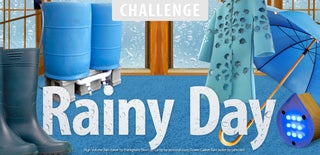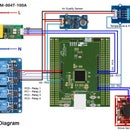Introduction: Power Your Bathroom by Water Tap
Shortage of Electrical energy is a big problem in my country and load shading occurs regularly here. So, most of the time I think about energy efficiency and renewable energy. Suddenly one thing came to my mind, why I am not using the water flow of bathroom water tap to light my bathroom. Bathroom does not required big energy. I used 7 watts CFL to light my bathroom. I replaced it by LED light powered by small hydro generator fixed to the water tap. It is working very well from two months.
You can put this system on the down pipes off the roof. You will get free power whenever it rains. Most cases the rain water just drains out into waste water pipes to go to the rivers and oceans anyway, so you can utilize it before waste away to the river.
I apologize for the dirty soap scum around the water tap. I live in a rental house and I found it in this situation. I tried to remove it but I failed.
Step 1: You Need...
- 3.6V Micro Hydro Generator (Seeed Studio)
- Screw thread (G 1/2", female) (local hardware store)
- 4-5W SMD LED module(4W led is equivalent to 7W CFL)
- Copper Wire
- On-off switch
Thread seal tape
Here I used G 1/2 micro hydro generator which can supply stably output voltage and output current with the help of builtin voltage stabilizing circuit and one rechargeable battery. Details here.
Step 2: 3.6V Micro Hydro Generator
This G1/2 micro hydro generator provides you clean and renewable electricity. With the help of the regulator circuit inside, the output of this generator is stable at 3.6V. And the capacity of battery is 300mAh.
Time to replace the Li-po batteries in your waterside projects with the green and more accessible hydro power.
Features
- Built-in Lithium Battery
- Built-in Lipo Charging Circuit
- Stabilized Voltage Ouput
- High Battery Capacity
Specifications
- Working Pressure: < 2KGF
- Pressure Drop: 0.4 Bar (3.0 L / Min )
- Peak Current: 1.4 A
- Stand-by Current: Max. 1.4A
- Voltage Output: 3.6VDC --- 700mAh
- Power Output: 125mW (4LPM)
- Battery Capacity: 300mAh
- Max. Flow: 20 L / Min ( 2KGF)
- Water-resistance: IP4
- High limited voltage: 4.3V DC
- Dimensions: L 84.5 mm - W 64.5 mm - H 81 mm
- Wire Length: 84 mm
- Jack Type: JWT C2521
- Connect Thread Gauge: G 1/2"
- Weight: 165 ± 5g
- Burst Pressure: 20KGF
- Normal Operation Temp. 4 °C~80 °C
- Max. Intermittent Operating Temp. 110 °C max. 30 min
- Generating Model: NACuM Core (PAT NO.DE202006004800)
- Battery Type: Li-polymer Battery with PCM
Step 3: Fixed Screw Thread to the Generator
Wrap the thread of arrow head side of the generator by thread seal tape and then attach screw thread to it. Thread seal tape help to tightly fixed the female screw thread with the male thread of the generator and protect from water leak.(images are attached serially).
Step 4: Attach Water Tape to the Generator
Again wrap some thread seal tape to the thread of water tap and tightly fixed it to the previously attached female screw thread to the generator.
Step 5: Wrap Seal Tap to Another Thread of Generator
You attached water tap in one side (arrow head) of the hydro generator. Now wrap some seal tap to another side thread of the generator which have to attached to the water pipe.
Step 6: Attache Generator to Water Line
Attache micro generator to the thread of wall pipe from where you removed the water tape before. Turn on the water tape and notice either any leakage is present or not. It not the OK, but if you find any leak then remove that joint and attach some more tape to the thread and re-fixed it.
Step 7: Test With LED Light
Connect LED light with the generator and turn on the tap. If light becomes on then congratulation!
Step 8: Complete Your Work
Connect an on/off switch with the 4-5W led light in series. Add some hot glue to every connection point to make it water resistance. Fixed led light to the wall of your bathroom (I used hot glue to attach the light to the wall). Connect light to the hydro generator. The generator used here has internal built-in Lithium battery, built-in Li-po charging circuit and Stabilizer circuit. So you need not to do anything without the simple connection of switch and light. One important thing is that the output voltage of the generator is 3.6V. So operating voltage of the attached led light must be 3.6V.
Step 9: Video Demo

Participated in the
Rainy Day Challenge

Participated in the
Brave the Elements Contest

Participated in the
Full Spectrum Laser Contest 2016













